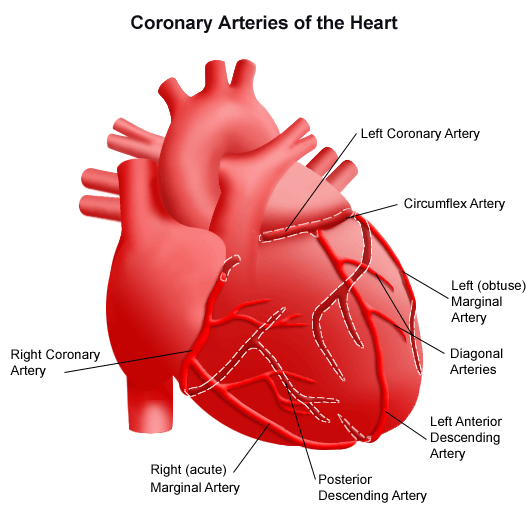Test Complete
- Questions
- Score
- Minutes
| Overall Results | |
|---|---|
| Total Questions |
| Category Results | |
|---|---|
THE QUICK AND DIRTY GUIDE TO CARDIOLOGY II
Category: Cardiology
Topic: Quick and Dirty Guides to Cardiology
Level: AEMT
Next Unit: The Quick and Dirty Guide to Cardiology III
10 minute read
The Quick and Dirty Guide to Cardiology II:
Coronary Circulation and Myocardial Infarctions

The heart is an organ whose muscles require oxygenated blood too!
Where does the heart muscle get its blood from? Where does it go? What happens when it's blocked?
Answer: 1) The heart gets its blood from arteries that branch off of the aorta called Coronary arteries.
Answer 2) Blood goes through the two main coronary arteries into the walls of the heart muscle.
Answer 3.) When there is a block in the coronary arteries and blood cannot pass through to the walls of the heart muscle, the muscle tissue dies. Then it is no longer able to "squeeze" and cannot help pump blood through your body. And then you die. This is how a heart attack happens!
Remember how blood leaves the left ventricle and shoots blood up over the aorta and to the rest of your body? Well, there are two branches off the aorta that go directly back to the heart. They are the Left and Right Main Coronary Arteries and they carry blood directly back to feed the heart oxygenated blood.

The Right Main Coronary Artery feeds the right atrium, right ventricle, inferior (lowest) muscle wall of the left ventricle, and most of the posterior (rear surface) of the left ventricle. We're not up to electrophysiology yet, but to peek over the wall, the RMCA also supplies food to the SA, AV nodes, and the near portion of the bundle of His. If there is ischemia(insufficient oxygenated blood flow) in the RCA, the AV node (atrioventricular) and SA node (sinoatrial) *sets the pace of the heart contractions,* is also affected. This is why your inferior MIs (dying heart tissue in the lower heart wall) almost always come with bradycardia (heart rate <60). Look at the picture above and see how the blood flowing from the right coronary artery supplies blood to the heart. When there is a blockage of blood flow in the RMCA, the muscle tissue of the heart that relies on its blood does not receive its oxygenated blood and starts to die without it. This is called a myocardial infarction or heart attack.
Left Main Coronary Artery (LMCA) branches into Left Anterior Descending (LAD) and the Left Circumflex. The left anterior descending (LAD) feeds the anterior and lateral surfaces of the left ventricle and the intraventricular septum. The left circumflex supplies blood to the left atrium, lateral wall of the left ventricle (with LAD) and in 15% of the people, also the inferior and posterior walls of the left ventricle. If there is a blockage in the left circumflex, the left atrium and part of the left ventricle will not get enough oxygenated blood and the muscle tissue there starts to die. The LAD is responsible for the most blood flow to the left ventricle, which is the main pump, so if there is a blockage in the LAD that reduces distal blood flow, there is a much-increased chance of death. That's why LAD blockages are known as "widowmakers."
Watch this excellent 3-minute video with a 3D simulation showing myocardial blood flow.
Video showing "hand mnemonic" for remembering which main coronary arteries do what...
So, a heart attack occurs when there is a blockage in the coronary circulation resulting in muscle tissue ischemia and muscle cell death! When you have inadequate blood flow and oxygen to your heart, it causes pain called Angina Pectoris, or "chest pain."
So, how do we know when this is going on and what do we do about it?
Check out MedicTests.com's Quick and Dirty Guide to Cardiology III where we discuss Chest pain assessment tools, how to get a good history, cardiac diagnostic techniques, and treatments that maximize survivability!